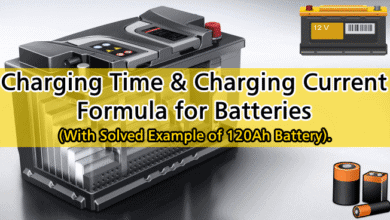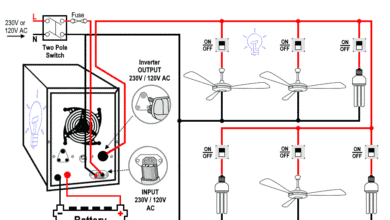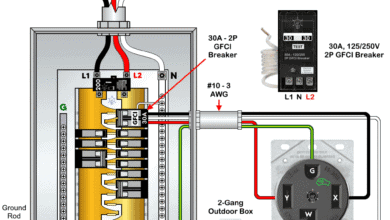How to Control Each Lamp by Separately Switch in Parallel Lighting Circuit?
Controlling of Each Lamp by Independent Single way Switch in Parallel Lighting Circuit?
In today basic home electrical wiring installation tutorial, we will show how to wire and control each lamp independently by using separate single way switches in parallel lighting connection.
Below is a simple step by step tutorial with schematic and wiring diagram which shows how to wire three different light bulbs in parallel to control from three different and independent switches and locations?
- Related Tutorial: How To Wire Lamps in Parallel?
Requirements:
- Single Way Switches (SPST = Single Pole Single Through) x 3 No
- Lamp (Light Bulb) x 3 No
- Short pieces of cables x 11 No
Procedure:
Connect all the wiring connection as shown in fig below.

- The first and second Lamps are glowing, because both the separate switches S1 and S2 which are connect to the bulbs through Line are at ON position and so the circuit is completed.
- The third Lamp is OFF, because switch S1 which is connected to light bulb through Line is OFF, so the circuit behaves like an open circuit meaning there is no way to flow the current in the circuit. Hence, bulb is not glowing
Related Post: Staircase Wiring Circuit Diagram – How to Control a Lamp from 2 Places by 2-Way Switches?
Now consider the following schematic wiring diagram. It is the same circuit as shown above but the switches and light bulb postpones just reversed i.e. S1 and S2 are at OFF positions, so Lamp 1 and Lamp 2 are OFF while S3 is ON and Lamp 3 is glowing.

Good to know:
- Switches and fuses must be connected through line (Live) wire.
- Connecting electrical devices and appliances like fan, outlet, light bulbs etc. in parallel is a prefer way instead of series wiring.
- Parallel or series-parallel wiring method is more reliable instead of series wiring.
Related Electrical Wiring Installations tutorials:
- How To Wire Switches In Series?
- How To Wire Switches in Parallel?
- How To wire Lamps in Series?
- How to control One Lamp from two or three different places?
- How to Control a Lamp by a Single Way or One-way Switch?
- Introduction to Series, Parallel and Series-Parallel Connections
- Difference Between Series and Parallel Circuit – Comparison
- Series, Parallel and Series-Parallel Connection of Batteries
- Which Bulb Glows Brighter When Connected in Series and Parallel & Why?







Good day sir,
I would like to know what will happen when the life wire charging the ups fail if there is power supply from the grid, what i mean is that if the power is supplied from the grid and from ups at the same time . what is going to happen if the power is supplied from 2 sources at the same time.
two way swich
I’m trying to find out how to wire up a new bathroom that I’m currently constructing and am kind of stumped, due to what I purchased -(mostly thanks to store guy’s suggestions).. I do know how to do basic electrical wiring correctly, been at it for ages, but these newer items confuse me to tears and I’d really appreciate any help/suggestions, and due to budget constraints I can not afford to call in an electrician, as legit ones are just way too overpricing here in NYC.
For starters, I bought plenty of 12/2 cable and an odd (to me this particular model is odd and very unlike one’s I’ve previously installed) 120v Leviton GFCI decor outlet -(Exact model # escapes me at the moment)- this one has 2 regular USA three prong receptacles on it, like they mostly all do and also has 2 USB charge ports (Micro-A and USB-C) on it’s front as well and also the usual test and reset buttons that all GFCI have and it has NO terminals on it anywhere at all, only 2 wires (B&W) coming out from the rear near it’s top -(and those say for receiving power)- (lead) and 2 wires (B&W) from it’s lower rear -(those say that they are only for sending juice to another outlet)- (load), and a green ground wire, but instead of using it to power up any other outlet(s), because there won’t be any other outlets in this small bathroom, I’d like to instead use it’s lead’s to power a double rocker light switch, if that is possible, just so that I wouldn’t need to run two power lines to the gang box, which the GFCI outlet and the double rocker light switch will share.
Each switch on the double rocker light switch will be controlling the on/off operation for each of two separate lights, meaning one switch for each light.
One light will be a recessed 24″, 2 fluorescent tube fixture, which will be mounted up on the ceiling and the other light will be a 5 incandescent Edison bulb light bar mounted up on the wall above the mirror. (sorry, they’re what the wife chose!)
I’m assuming that since each switch will need to work each light independently I would need to snap the tab off, so that each switch doesn’t operate both lights.
Does that mean I would need to power each switch?, or will one lead wire power up both?, even with the tab removed? Or do I leave the tab?
I do know that I will need to run a length of cable from each switch up to each light and I do know that I have 1 power cable coming into the bathroom that will go directly to the outlet first.
Only diagrams I find for the type of outlet I bought are for wiring multiple outlets, so those don’t help me and light switch diagrams I find for double switches are for wiring a light and fan.
If anyone out there understands what I’m trying to do and knows about the type of outlet and double switch I’m trying to use and has some suggestions, tips or can help I would deeply appreciate it!
Thank you!